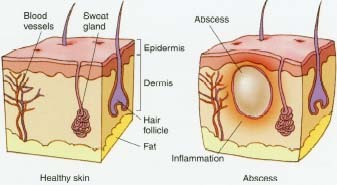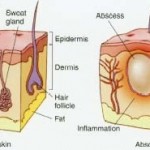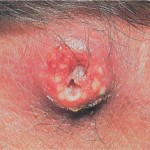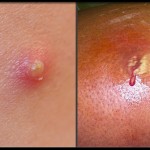Skin Abscess Diagnosis
The doctor will take a medical history and ask for information about the following:
- How long the abscess has been present
- If the patient recalls any injury to that area
- What medicines the patient is taking and if there are any serious or chronic medical conditions
- If the patient has any allergies
- If the patient had a fever at home
- The doctor will examine the abscess and surrounding areas. If it is near the anus or vagina, the doctor will perform a rectal or vaginal exam. If an arm or leg is involved, the doctor will feel for an enlarged lymph node either in the groin or under the arm.
- Depending on the location and the extent of the abscess, the doctor may obtain wound cultures or blood tests and imaging studies, although these measures are often not needed.
- If the abscess is small (less than 1 cm or less than ½ inch across), applying warm compresses to the area for about 30 minutes, four times daily may help.
- Do not attempt to drain the abscess by pressing on it. This can push the infected material into the deeper tissues.
- Do not stick a needle or other sharp instrument into the abscess because it may injure an underlying blood vessel or cause the infection to spread.
Medical Treatment
Often, a skin abscess will not heal on its own without further intervention by your health-care provider. Initially, an abscess may feel firm and hardened (indurated), at which time incision and drainage may not be possible. However, once the abscess begins to “come to a head” and it becomes more soft and fluctuant, lancing it to evacuate the pus and relieve the pressure is the best course of action. Your health-care provider will open and drain the abscess (incision and drainage) using the following technique.
- The area around the abscess will be numbed with local anesthetic.
- It is often difficult to completely numb the area, but in general, local anesthesia can make the procedure almost painless.
- A sedative may be given if the abscess is large.
- The affected area will be covered with an antiseptic solution and sterile towels placed around it.
- The health-care provider will cut open the abscess with a scalpel and drain all of the pus and debris. Sometimes, there will be multiple pockets of pus that must be identified and drained.
- Once the sore has drained, the doctor may insert packing into the remaining cavity to minimize bleeding and to keep the wound open for a day or two so any remaining pus can continue to drain.
- A bandage will then be placed over the packing, and the patient will be given instructions for home care.
- Most people feel better immediately after the abscess is drained.
- Your health-care provider may prescribe pain medication, depending upon the location, size, and extent of the abscess.
- Antibiotics are generally not necessary; however, they may be prescribed if the abscess is associated with a surrounding skin infection. Antibiotics may also be prescribed, depending upon the location of an abscess and whether or not the individual has a compromised immune system.
- Carefully follow any instructions regarding wound care recommended by your health-care provider.
- Your health-care provider may have the patient or the caregiver remove the packing. If so, it is best removed while the area is moistened with water.
- After the packing has been removed, soak or flush the area for 10 to 20 minutes, three to four times daily to allow the wound to heal properly.
- Be sure to keep all follow-up appointments as your health-care provider may want you to return for a recheck of the wound. Sometimes the wound may require repacking if it continues to drain pus.
- Report any fever or increased pain or redness to your health-care provider immediately.
Skin Abscess Prevention
- Maintain good personal hygiene by washing the skin with soap and water regularly.
- Take care to avoid cutting yourself when shaving your underarms or pubic area.
- Seek medical attention for any puncture wounds:
- Especially if the person thinks there may be some foreign material or debris inside the wound or under the skin
- If the person has one of the listed medical conditions that may weaken the immune system
- If the person is on steroids, chemotherapy, or dialysis.
- Once treated, the skin abscess should heal. The prognosis is generally excellent, but some individuals may suffer from repeated abscesses requiring medical attention.
- Most people do not require antibiotics.
- The pain should improve almost immediately after drainage and subside more each day.
- Soak or wash the area daily until the wound heals — about seven to 10 days.
- Usually you can remove the packing by the second day. It rarely needs to be replaced.
- After the first two days, drainage from the abscess should be minimal to none. All sores should heal in 10 to 14 days.



